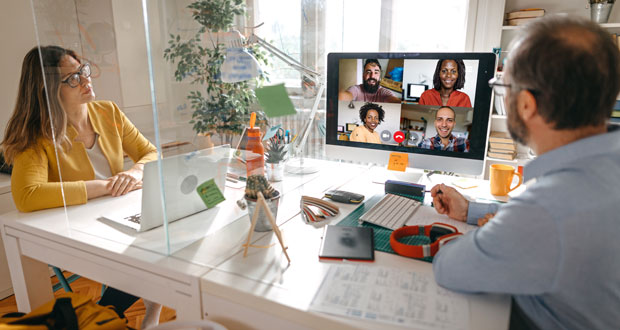 THE DESIGN EXPERT’S VIEW
THE DESIGN EXPERT’S VIEW
SONIA BROWN,
DIRECTOR & HEAD OF DESIGN AT HUMAN BY QUADRANT DESIGN
The pandemic will have a lasting impact on the evolution of workplace interiors. People have been used to working in an intimate home environment and that needs to spill into the office.
Navigation through a space needs to allow for social distancing but be more organic and less restrictive. This will be achieved by demarcation on floors and positioning of furniture. Using furniture to create zones means it can be reconfigured – flexibility is key. Rows of long desks need to be separated, creating neighbourhoods of desks interrupted by break out zones to encourage socialising.
Gone are the days of offices at 100 per cent capacity. If people are only in the office two or three days a week, they need to be able to communicate and socialise with other people. If staff come in and end up at a fixed seat on a bank of desks on their own it will only ignite the feeling of isolation and loneliness that we all want to break free from. Hot desking is a quick win solution to accommodate staff flexibility and encourage people to sit together.
As the office space becomes more agile, IT functionality will need to follow suit and be much more plug-and-play and adaptable to different settings. We’ve all got used to home comforts over the last fourteen months and office interiors will need to bring elements of that into the workplace. Soft furnishings add warmth and cosiness, so drapes and cushions will be in high demand. Personal motivators like prints and props will also help people feel more at ease when they return to work.
People often have more colour in their homes than might be typically found in a traditional office. Dark colours absorb light while white reflects it back which can be problematic for continuous screen use. Green and blue are calming, natural colours and add more comfort and security than white or grey. Colour will go a long way in adding warmth and creating a home-from-home feel.
Office colour and design should reflect a company’s brand and culture. It’s important to embrace colleagues back into the brand they work for after being disconnected for so long. How do you want your brand to make your staff and visitors feel? The office design should mirror that feeling.
With remote working, people have enjoyed more activity-based working. People might work at the kitchen table for a few hours, hold one to ones on the sofa or move to the garden to read. This breadth of choice will need to be replicated in the workplace to draw people back to the office.
Businesses need to be clever about how they manage their corporate real estate. Multipurpose spaces are the solution. Space needs to be adaptable enough that it be a social lunch or TV space or a meeting area. Meeting rooms can also double up as mediation or prayer rooms. The office needs to be agile enough to accommodate day to evening activity and cater for pop-up events and hospitality. The office is not a 9am-5pm location anymore. The office as we know it is transforming and should not be restricted by the parameters of being an office. It needs to be much more than that.
 BRITISH COUNCIL OF OFFICE’S VIEW
BRITISH COUNCIL OF OFFICE’S VIEW
RICHARD KAUNTZE,
CHIEF EXECUTIVE BCO
Although many of us see getting back to the office as a welcome return to ‘normality’, it’s apparent that, post-pandemic, the workplace will be rather different. Necessarily, we’re now far more cognizant of safety and hygiene concerns, and our year of home-working will undoubtedly influence the layout and features of our company workspaces in the months and years ahead.
The most immediate adjustments to be made are those designed to facilitate COVID-secure cleaning regimes and allow for social distancing, changes that are generally necessary for offices to reopen at all. In April 2020, the BCO released a briefing note on safe office design during a pandemic, and we expect to see many of these suggestions adopted by companies hoping to protect returning office workers. Some employees may have an aversion to desk-sharing, so the office layout will have to be rethought to allow for socially-distanced workspaces. Similarly, office designers will have to be conscious of any potential ‘congestion points’ (such as kitchens and lifts), so that ‘traffic’ to these areas can be regulated through intelligent design.
Expect to also see more small collaborative conference rooms, which are generally a better use of space than rows of desks and allow employees to take calls with colleagues working from home without disturbing the main (typically open) working space.
In the longer term, what else might we expect to change in our offices? Though the novelty of working from home has long since worn off, being able to work with our home comforts has been a saving grace for many. Accepting this, the value proposition of the office must improve to entice workers out of their homes and into the office.
A recent BCO webinar explored the impact the pandemic has had on the design philosophies of some of Canada’s top developers, and opinion was unanimous that offices will have to improve their interior design, use of environment and quality of amenities if they are to continue to act as a ‘hub’ for employees.
Gone will be the days of sterile corporate lobbies; instead, offices will need to provide employees with value beyond a desk and a chair, in the form of social spaces, recreation amenities and interactive collaborative spaces. The introduction of higher ceilings, better natural lighting, and greater variation of textures can elevate the feeling of comfort and warmth in the workplace.
An office should be more than a sum of its features – it should act as a reflection of a company’s values and culture. By doing so, an office can be of great benefit to an employee’s wellbeing and continue to attract the most talented people, who will undoubtedly be more productive as a result.
Ultimately, any changes to the design of offices, whether in the short or longer term, will be made with the wellbeing of employees in mind. So, despite the disruption of the past year, we can be confident that our offices will come out better for it.
 THE PROPTECH EXPERT’S VIEW
THE PROPTECH EXPERT’S VIEW
STEVE MORREN,
DIRECTOR OF CHANNEL SALES EMEA, IOFFICE
iOFFICE commissioned independent research firm Verdantix to canvass the opinions of FM, workplace, and CRE thought leaders across the globe on managing employee experience in a hybrid world.
The interviews revealed that the sudden shift to dispersed working has led to numerous new challenges, each with lessons for implementing a hybrid model post-pandemic. Most notably, interviewees said that dispersed working had damaged opportunities for social interaction and collaboration. The workplace is a forum where people can socialise and build connections with the colleagues they don’t work with directly, making it easier to build company culture and break down departmental silos.
A combination of workplace technology will allow FM teams to meet these new demands. By integrating occupancy sensors and analytics with space booking tools, access control, and customer experience apps, organisations can ensure that the employee experience stays consistently high despite occupancy changes in a flexible model.
In the short term, organisations also need to ensure that workplaces are sanitised and safe. The virus will still be a threat past 21 June, so FM teams will have to maintain enhanced cleaning regimes and distancing measures. With many employees anxious about returning to the office, it’s essential for firms to instil confidence by taking appropriate action. Integrating occupancy and space booking tools with service requests will allow cleaners to sanitise surfaces based on use, especially in flexible or hot-desking areas where employees share workstations and meeting rooms.
Looking further ahead, the data from these tools can help organisations design employee experiences in line with not only demand but also activities and roles, behaviours, and workstyles. The biggest mistake anyone can make is to assume that one size fits all in hybrid working. If the pandemic has taught us anything, it’s that everyone has different requirements for their work environment.
Facilities managers can use occupancy and space usage analytics to build accurate employee personas, thereby identifying individual needs. From here, they can work with HR, real estate, and technology teams to create the best flexible working models and activity-based workspaces.
Finally, these tools can ensure that organisations do not neglect social interaction in the pursuit of flexibility. Data from occupancy and space booking tools can help shape employee behaviour while improving efficiency. If occupancy sensors determine that a space is underutilised, facilities managers can designate it for social events that encourage people back to the office and build that all-important company culture.





